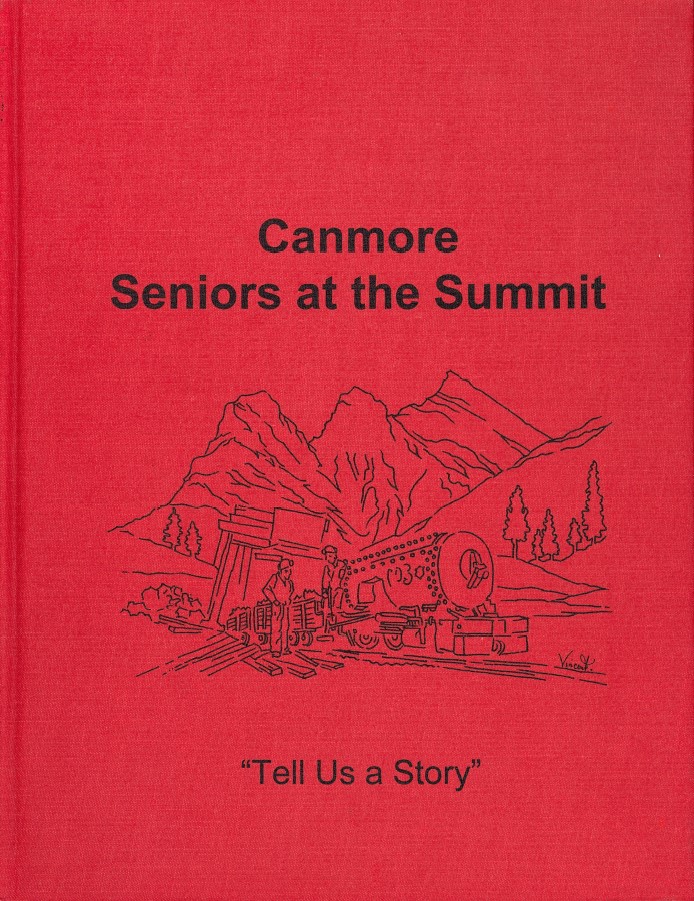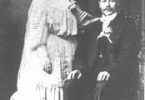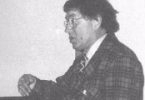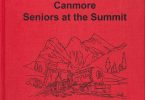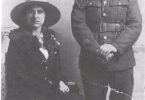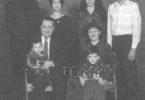Canmore? Where is that? Such was the question asked of me, for many years, while I was growing up in Canmore. Some people knew. Hockey fans knew of our Canmore Senior Hockey team. It was the only senior team to win the Alberta Amateur Hockey Championship three consecutive years in the late twenties. Also people associated with First Aid throughout the Dominion knew where Canmore was. They knew that Canmore First Aid teams had won the Alberta Championship on numerous occasions and the men, ladies and intermediate boys had each won the Dominion Championship on two occasions respectively. I’m a little ahead of myself extolling the virtues of Canmore: let me go back to my arrival in Canmore.
The Dewis family consisting of Cliff and Grace Dewis, their three boys, Frederick (Fred), John (better known as Jack), and Marshall (Marty for short), arrived from Calgary in November, 1918. Dad Dewis had accepted the job as assistant engineer with the Canmore Coal Company. Their moving in was not a joyous affair as noted in Dad’s diary of November 1918. His description of the house was not flattering: A so called seven room house, moved down from Georgetown, slapped together, one room papered and the rest joint varnished, scratched and dirty. The horses had used it for a shelter from the flies, the floors were in beautiful shape. It was located next to the old skating rink. However, years later, with additions to four sides and the grounds landscaped, I considered myself very lucky to have had the luxury of a fine home.
Hockey was always the premier sport. We all played hockey from November to March either in the rink, on the river, or “behind Canmore” as we called it, on the spring-fed pond a stone’s throw from Main Street. Summers were wonderful times. We had our favorite swimming holes, took numerous hikes up the river and, in later years, up the mountains. There were sport days, whistdrives, dances, plays, bridge clubs, debating society, First Aid classes, baseball, football, (soccer), fishing (world’s best), curling, golf, carnivals, band, three churches, Memorial Hall, Union Hall, Legion Hall, and so it goes on and on. As Dad aptly put it in his diary of March 1921, Canmore is sure one busy place in the social line in the winter. There is something every blessed day of the week.
There are many memories that are outstanding of the years that I actually lived in Canmore, 1918 – 1936. (The folks moved back to Calgary in 1950.) Such things as feeding deer at our back door during the winter months, playing hockey on a line with Stosh Chakowski and John Kaleta for a number of years, and hiking and swimming with Robert Baxter during the summers, are some of them. Memories of my teachers, Ada Wright, Edna Hill (Appleby), Tom Bailey, and Munroe Macleod whose teaching expertise I didn’t really appreciate until years later when I got to know them on a more personal basis. Memories of walking to church on the board walks and having a loose board fly up and hit you on the shins. The board walk system was a disaster as it never was kept in shape.
Canmore suffered during the Depression years but not to the same extent as the farmers and people in some other trades. The mine only worked two to three days a week, but we had food, clothing and shelter. The Company extended credit to their employees at the company store so nobody went hungry. Fellows riding the rods would stop off at Canmore for a meal. Mother was always a soft touch when it came to feeding the hungry. Most of the fellows offered to do odd jobs in return for food. There were relief camps just east of Canmore. The men were under canvas and worked on the Calgary – Banff highway. For their efforts, they received room and board and $5.00 a month spending money. There were many fine fellows in these camps and they were welcomed into our community.
In 1936, I followed brothers, Fred and Jack, to the University of Alberta. Following graduation, I joined the RCAF and spent my war years as a navigator on Coastal Command on the east coast of Canada doing convoy patrol. Fred also joined the Air Force. He was lost on a bombing mission over Germany. Jack joined the Senior Service, as he was wont to call it, the Navy. Following the war, he remained in the Navy, eventually retiring as a captain and as Deputy Judge Advocate General of the Armed Services. He has resided in Ottawa since 1944. My career included twenty-four years in Geophysics and fifteen years in Commercial Industrial Real Estate. Calgary has been my home for the past thirty-seven years.
The folks remained in Canmore until 1950. They moved back to Calgary and built a house on a lot that Dad had bought in 1912. Dad passed away in November, 1966, at age 87. Mother died
in February, 1968, at 84 years.
I would be remiss not to mention one who has become Canmore’s most famous citizen. Lawrence Grassi earned the respect of everyone in Canmore. He possesed a quiet manner and a willingness to help whoever he came in contact with. The trail he built to Twin Lakes (renamed Grassi Lakes) in the early thirties has served enormous pleasure to thousands of people who have hiked the trail to view the lakes. I remember the day in 1937 that I met Lawrence on the street in Canmore. He said that he was getting old (early 40’s)] and as the ascent route up to the first (little) sister was not well-known, would I be interested in making the climb with him? We set a date for the latter part of August, but due to an important climb for him that later arose, we had to postpone the trip. We set a date for the first week in September, but unfortunately, I had to return to the University earlier than I had planned. The thrill of climbing with Grassi and the thought of what I could have learned about mountain climbing practically haunts me to this day.
I visit Canmore several times a year, basically to hike the trails and get to the top of the odd mountain. Canmore has one of the most beautiful settings you’ll find anywhere in the world. The broad valley with the rolling hills to the base of the mountains is really quite unique. I don’t look at the valley as being spoiled by the development. Rather I think it is great that so many people are now able to enjoy such a beautiful area. On the whole, I think the planning has been excellent. They even left two of the spruce trees that grew in our front yard standing, where a condo complex now sits. I wish all the people of Canmore will continue to enjoy the valley as much as I did and still do.
Excerpts from Diary of Clifford S. Dewis
Clifford S. Dewis, Engineer with the Canmore Coal Co. from 1918 to 1950, kept a book in which he wrote three or four times a year the major events that had transpired during the past interval. Recorded below are some of the events that may be of interest to those wishing to gain a little knowledge of the early days of Canmore. The following is a summary compiled by his son, Marty.
February 9, 1919
Moved to Canmore on November 22, 1918, to take on the job as Assistant Engineer under George Elliott. Wife Grace and our boys Fred (5 years), Jack (2.5 years) and Marshall (Marty, 18 months) along with George and Amanda Pineo, parents of Grace.
A mistake of 15 degrees 15 minutes in the mine survey was discovered by Elliott necessitating a resurvey of the entire mine workings that could be reached. This took many hours of extra work to rectify.
May 25, 1919
Fred came running in one day saying that Jack had fallen down the outside toilet. Mother found him hanging by his hands and was able to pull him out, none the worse for the experience.
Alberta Coal Miners went on strike. The main issue is for an 8 hour work day for the outside workers. Attempts were made to form one Union for all industrial workers. It was termed OBU (one big union). The idea failed.
July 17, 1920
Miners and salaried personnel with the company received a 14% wage increase effective the 1st of December, 1919 as a result of a new agreement with the UMW of A.
September 1, 1920
Grace and her friend Lou Taylor of Boston, along with 3 other Canmore ladies climbed Lady MacDonald. Picture in Canmore Museum and also at the A&W.
Dad appointed to Board of Managers of the Presbyterian Church. Company donated old house from Georgetown to be used for a manse. Described as being in sorry condition.
Cleared a site in our back yard for croquet and a skating rink.
Big sports day to be held on Labor Day. All children to receive a nickel and tickets for ice cream, candy and peanuts.
March 8, 1921
Company built a lean-to to the skating rink for two sheets of curling ice.
Four competitions held:
- H.W. Evans cup
- Chicken dinner donated by Grace Dewis.
- 4 boxes of 2 dozen cigars donated by Art Latimer, Mgr. of Co. store.
- C.T. Sing store donated a $4.50 box of chocolates. Points were used to determine the winner.
On January 25, a 3-inch pipe from the Carey pump to the Three Sisters Dam broke, flooding a portion of the mine. Pumping at 1000 gallons per minute, they estimated that it would take 10 weeks to clear the mine.
The CPR made a big splash that they were going to need a lot more coal due to the shortage of oil. In anticipation of more orders, the company did the following:
- New Box Car Loader
- Addition to Bath House
3.25 new houses
4.$50,000 Memorial Hall and Y.M.C.A.built
The orders never materialized.
Dad took census of the town in April. Population was 1005. Largest family was a couple with 8 children 14 years and under.
Dad and Mother joined a bridge club.
June 18, 1922
George Elliot left the company and Dad became the Chief Engineer.
Stepped down as President of the Curling Club for the past two years but took over as Secretary as no one volunteered.
April 1, all miners on the continent went on strike. A conciliation board recommended a 25% cut and open shop. Not a binding report – no news if it was accepted. A number of people left town during the strike and didn’t return.
Competition for the Simpson Cup (for curling) was fierce. Canmore took it from Field, defended it against Banff, and then lost it to Bankhead.
May 20, 1923
New tipple contract let for $42,430 to an Edmonton Iron Works.
New dam built on Three Sisters Creek to keep water out of the mine.
April 27, 1924
New tipple “colossal bungle” due to interference of GM M.B. Morrow.
Another strike. One issue was the removal of the $1.17 a day war bonus by the company.
Elks formed a lodge November 23, 1923.
Station Agent Dave Thompson left after 12 years.
August 11, 1924
Strike still in effect.
Munroe McLeod, the new school principal got married. Company built a new house for them, cost $4800.
December 12, 1924
Strike ended October 27 – lasted 6 and a half months. Miners lost the $1.17 war bonus and other cuts of 12 and a half percent.
Norman Wait, one of Dad’s assistants, resigned, and replaced Miss Cowan, a school teacher, who contracted TB and was in the Calgary Sanitarium. They later married.
Busy with Mine Rescue work and First Aid. Had to give up Sunday school class to take in the F.A. as it was held Sunday morning.
April 5, 1925
Company personnel received a 20% pay cut. New Tipple cost running into the and won’t do anything more than the old tipple could do.
June 7, 1925
Majority of company officials signed a letter of grievances and forwarded it to Mr. Beal, the company president. Result was that M.B. Morrow was replaced by Mr. W.H. Wilson. Employees told that Morrow was taking a 6 month leave of absence. New agreement made with a 17 and a half percent pay cut. Briquette plant started.
Canmore Players put on another play at the Odd Fellows Hall – “Facing the Music”
Dr. White, minister of the Presbyterian Church resigned as he preferred to stay with the Presbyterian group rather than the new United Church.
October 22, 1925
New briquette plant about completed. M.B. Morrow was officially terminated.
March 9, 1926
Canmore Players put on a play “Safety First” Two performances in Canmore and one in Banff.
Elks held their annual Winter Carnival. Canmore Sr.hockey team played Vancouver for the AB-BC championship. Canmore lost.
Briquette plant off and running. Made a few car loads and then had to shut down due to lack of orders.
W.H. Wilson’s 6-month contract expired and he was replaced by Mr. R.M. Young as general manager.
Harry Hunter, one of the engineering assistants, returned to University. He later became general manager of Canadian Western Natural Gas Co. in Calgary.
Bought a 2nd hand electric washing machine for $80. “It has been a Godsend to Grace”
April 19, 1927
Canmore Golf Club formed. The mine working 4 to 6 days a week. Briquette plant orders could be better.
March 12, 1927
Dad’s Mother in Advocate Harbour, N.S. passed away 17 Sept, 1926.
Elks held a carnival in February complete with Carnival Queen and a dance.
Canmore Sr. Hockey team played Trail in Vancouver for the Western Championship but lost out. Many of their star players of the previous year had left including Percy Jackson, the Trail goalie.
Canmore put on their first curling Bonspiel. 14 rinks from Canmore, 5 Banff, 1 Calgary and 1 Revelstoke.
July 29, 1927
Lawn Party for the new Union Church held in Dewises’ yard, complete with band.
All miners examined by Provincial Inspectors. Must be able to read and write English. Came down pretty hard on some of the European miners.
April 20, 1928
Miners on strike March 20th because two miners that loaded powder in one of the mine cars and sent it out through to the bunkers; were fired as a result. Went back to work on June 1.
September 8, 1928
Heavy snow fall on June 6 and 7th caved in the roof of the skating rink and lean-to at the curling rink. Mr. Neal approved new skating rink with steel girders at an estimated total cost of $13,000. Curling rink approved if town would clear site and donate some labor. Total cost $2,000. Ben Fears was the general foreman and Harry White on the steel.
10,000 people were brought to Canada to help with the harvest. However, many did not go to the farms as noted, some ended up in the mines instead.
August 4, 1929
A flu epidemic swept through Canmore and a number died, including Mrs. Robert Baxter. There was also an outbreak of diptheria.
Elks held big Kiddies Day. 300 kids each got a flag, dime, 2 ice cream cones, chocolate bar, a bag of peanuts besides prizes for races.
Acted as cook for the setting up party at the Y Camp at Bowfort Lake.
November 14, 1931
Fred Dewis and George Mussoli entered University of Alberta in September.
Whole world in depression for the past year.
December 5, 1931.
Arthur Colebrook from Banff took over the Post Office from Stewart Lynch who moved to Calgary. Arthur is the brother of Ernie Colbrook, one of the store clerks.
The coal business is in bad shape. Mine working 2 days a week.
Newspaper started by Ernie. Dennison Garner as Editor “Canmore Times”, twice a month publication. Stan Young, the YMCA secretary was also involved in the production of the paper.
March 13, 1932
Mine still only working two days a week. Strike being threatened at termination of existing contract on March 31.
Jim Hill, pit boss, had a heart attack and ordered to bed for 3 months.
April 3, 1932
“Roped in again for Secretary of the Curling Club and President of the Golf Club”.
October 1, 1932
Bears very plentiful in town. One tore the end out of the walk-in refrigerator at the company store. Was shot by Constable Cook of the RCMP.
Mine working 2 to 3 days a week.
March 20, 1933
Fred Dewis was first Canmore student to graduate from the University of Alberta.
Collected another deer head for visitor prize at the Banff Bonspiel. Team of C.S. Dewis, Art Latimer, Ed Erickson and Jack Anderson. Note: This deer head has been donated to the Canmore Curling Club by Marty Dewis.
May 24, 1933
Legion Club offered prizes for the best lawns, gardens, etc. resulted in everybody sprucing up their residence grounds.
Banff-Canmore golf tournament gave Canmore 11 out of 12 matches.
Reviewing his activities Dad listed a number of reasons he was so busy.
President of Golf Club
Secretary of Curling Club
President of First Aid Class
Secretary Board of Managers of United Church
Chairman Finance Committee for July 1st sports
Cook for Y camp set up
Note: Dad was involved in the above committees for many years as well as the Elks. If there is ever a Canmore Citizen of the Century selected, Dad should win it hands down.
March 12, 1935
Jack off to the U of A last fall.
Harry Evans passed away last August
Coal business bad.
Oxford Group got quite a gathering in Canmore.
Social Credit swept the Province.
HorticulturalSociety going strong.
Last year (1934) the men and ladies First Aid teams both won the Dominion championship. The men repeated in 1935 as well as the Intermediate team of John Colbrook, Vincent Cole, Joe Riva, George McPherson and Marty Dewis.
Note: From 1936 on, Dad started keeping a daily diary. At the time of his passing I sorted through his diaries and made the decision to throw them out. At times I regret this, but what do you keep, there’s so many things?
In Canmore Seniors at the Summit, ed. Canmore Seniors Association, 2000, p. 55-60.

